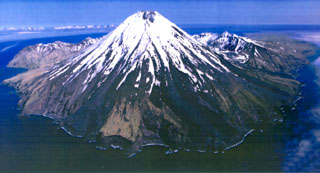Report on Kanaga (United States) — September 1994
Bulletin of the Global Volcanism Network, vol. 19, no. 9 (September 1994)
Managing Editor: Edward Venzke.
Kanaga (United States) Minor ash emission
Please cite this report as:
Global Volcanism Program, 1994. Report on Kanaga (United States) (Venzke, E., ed.). Bulletin of the Global Volcanism Network, 19:9. Smithsonian Institution. https://doi.org/10.5479/si.GVP.BGVN199409-311110
Kanaga
United States
51.923°N, 177.168°W; summit elev. 1307 m
All times are local (unless otherwise noted)
Eruptive activity continued in the second half of August with emissions of steam and minor amounts of ash on 20-21 August. A shift in wind direction produced light ashfall in Adak on 20 August and temporarily disrupted air traffic to Adak on the 22nd. Weather clouds frequently obscured Kanaga from late August through mid-September. Preliminary analysis suggests the ash is broadly similar in composition to other known tephras and lavas from Kanaga.
Observers reported white steam clouds rising to 600 m above the summit on 8 September; occasional low rumbling noises were also heard. Weather clouds obscured Kanaga for much of 16-30 September, but AVHRR satellite images indicated a steam plume extending ~50 km S of Kanaga on 22 September. . . . .
Geological Summary. Symmetrical Kanaga stratovolcano is situated within the Kanaton caldera at the northern tip of Kanaga Island. The caldera rim forms a 760-m-high arcuate ridge south and east of Kanaga; a lake occupies part of the SE caldera floor. The volume of subaerial dacitic tuff is smaller than would typically be associated with caldera collapse, and deposits of a massive submarine debris avalanche associated with edifice collapse extend nearly 30 km to the NNW. Several fresh lava flows from historical or late prehistorical time descend the flanks of Kanaga, in some cases to the sea. Historical eruptions, most of which are poorly documented, have been recorded since 1763. Kanaga is also noted petrologically for ultramafic inclusions within an outcrop of alkaline basalt SW of the volcano. Fumarolic activity occurs in a circular, 200-m-wide, 60-m-deep summit crater and produces vapor plumes sometimes seen on clear days from Adak, 50 km to the east.
Information Contacts: AVO.

